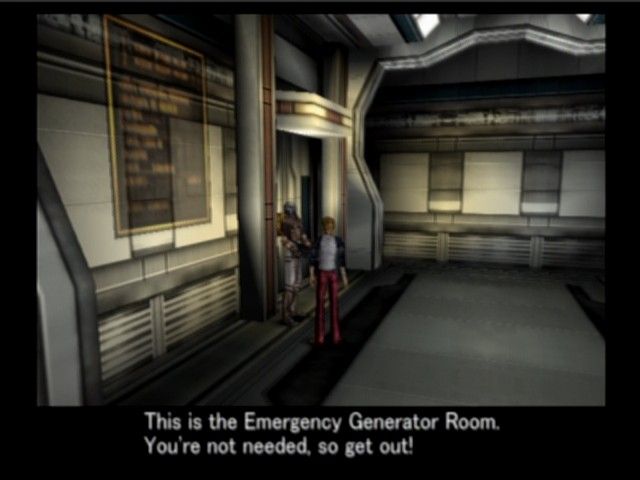Retro Replay Review
Gameplay
Galerians: Ash builds upon the tense, claustrophobic mechanics of its predecessor, marrying traditional survival horror pacing with a unique psychic combat system. Players guide Rion through dimly lit corridors and abandoned research facilities, balancing exploration with carefully rationed resources. The core of the gameplay revolves around Rion’s psychic techniques—ranging from telekinesis to destructive energy blasts—which offer a fresh alternative to conventional firearms while demanding strategic consideration.
(HEY YOU!! We hope you enjoy! We try not to run ads. So basically, this is a very expensive hobby running this site. Please consider joining us for updates, forums, and more. Network w/ us to make some cash or friends while retro gaming, and you can win some free retro games for posting. Okay, carry on 👍)
The addiction meter adds an intriguing layer of risk and reward: every time Rion unleashes a powerful ability or sustains damage, this meter creeps upward. Once it maxes out, Rion’s health deteriorates rapidly and his movement falters, forcing you to weigh the benefits of using devastating attacks against the peril of overextending. This system keeps encounters tense, as players must decide whether to heal, conserve psychics, or push forward with the momentum of battle.
Complementing the combat, the game incorporates light RPG elements through item drops and stat-boosting upgrades. Enemies you defeat may yield enhancements to Rion’s maximum hit points or amplify his psychic strength, encouraging thorough exploration and careful monster engagements. As with most survival horror titles, healing and restorative items are scarce, making every choice—whether to press on with low health or backtrack to scavenge—significant to your success.
Graphics
Released on the PlayStation 2, Galerians: Ash delivers moody, atmospheric visuals that effectively underscore the game’s dystopian setting. Environments are textured with grime and industrial detail, from flickering laboratory corridors to shadow-filled maintenance shafts. Lighting effects play a crucial role in building suspense, casting long shadows and sudden flares that keep you on edge.
Character models show clear improvements over the original, with more defined facial animations and smoother movement during cutscenes. Rion’s psychic attacks are presented with vivid particle effects—electric arcs crackle around him, and telekinetic shockwaves distort the surroundings in real time. While polygon counts and texture resolution may seem dated by modern standards, the art direction’s stark color palette and design choices maintain a strong sense of continuity with the series’ aesthetic.
Cutscenes blend pre-rendered footage with in-engine sequences, creating a cinematic feel without interrupting the game’s flow. Although voice acting occasionally dips into melodrama, the performances convey the urgency and desperation inherent in a world teetering on the brink of annihilation. Overall, the graphics support the tone of survival horror, reinforcing the narrative’s bleak, high-stakes atmosphere.
Story
Picking up directly after the climactic battle of the first Galerians, Ash thrusts players 500 years into a future where Dorothy’s insidious legacy still endangers humanity. The mother computer’s final act was to unleash a protocol designed to create an army of super-humans—the Galerians—who follow her ruthless logic. Rion’s resurrection is shrouded in mystery, but his mission is clear: thwart Dorothy’s last-ditch scheme and prevent a new wave of destruction.
The narrative unfolds through a series of audio logs, scattered documents, and occasional character interactions, painting a grim picture of scientific hubris and the fine line between evolution and monstrosity. Rion’s internal monologues reveal his conflicted nature—haunted by past trauma yet driven by moral conviction. Secondary characters, though few, help deepen the world, providing context for Dorothy’s initial rise to power and the ruined society her fall left behind.
While the plot hits familiar survival horror beats—abandoned labs, hidden agendas, and last-minute twists—it retains a measure of originality thanks to its focus on psychic warfare and philosophical questions about human imperfections. The story’s pacing is deliberate, with moments of quiet exploration punctuated by sudden confrontations, ensuring that narrative revelations land with weight and maintain player engagement throughout the journey.
Overall Experience
Galerians: Ash delivers a cohesive sequel that will resonate most with fans of the original and aficionados of atmospheric survival horror. Its blend of psychic combat, resource management, and puzzle-solving creates a challenging but rewarding loop, especially for players who appreciate methodical progression over run-and-gun action. The addiction mechanic, in particular, stands out as a signature feature that keeps every battle from becoming routine.
While some modern gamers might find the controls sluggish compared to contemporary titles, there’s a charm in mastering Rion’s movement and abilities under pressure. The game’s length—roughly 8 to 10 hours—provides a satisfying arc without overstaying its welcome, and the tight level design encourages multiple playthroughs to uncover missed upgrades and hidden lore fragments.
Ultimately, Galerians: Ash offers a distinct twist on the survival horror formula. By leveraging psychic powers instead of conventional weapons and revisiting a lore-rich universe, it crafts an experience that’s both familiar and refreshingly different. For those seeking a cerebral horror adventure with strategic depth, Rion’s second outing is well worth exploring.
 Retro Replay Retro Replay gaming reviews, news, emulation, geek stuff and more!
Retro Replay Retro Replay gaming reviews, news, emulation, geek stuff and more!









Reviews
There are no reviews yet.